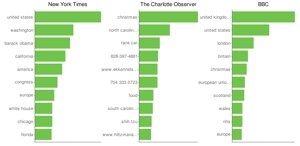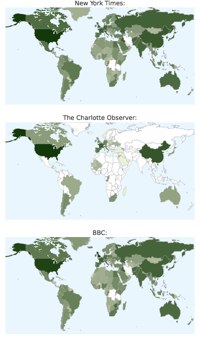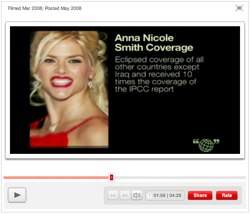I learned about this one via a reference from Doug Peterson from Facebook. It reminds me of, and is probably related to, a famed TED Talk by someone from the Berkman Center for Internet & Society did about how news seems to focus on western societies and the U.S. specifically. I haven’t seen that video, so am probably getting this wrong.
But Media Cloud is a pretty cool tool from the Berkman Center.
Media Cloud automatically builds an archive of news stories and blog posts from the web, applies language processing, and gives you ways to analyze and visualize the data. The system is still in early development, but we invite you to explore our current data and suggest research ideas. This is an open-source project, and we will be releasing all of the code soon. You can read more background on the project or just get started below.
 The graph to the right illustrates the top ten terms in the New York Times, BBC, and the only North Carolina newspaper included in the tool. For the NYTimes the top terms were united states, washington, barack obama, and california. For the BBC, they were united kingdom, united states, london, and britain. For the Charlotte Observer, they were christmas (which also showed up on BBC’s list), north carolina, race cars, and somebody’s phone number.
The graph to the right illustrates the top ten terms in the New York Times, BBC, and the only North Carolina newspaper included in the tool. For the NYTimes the top terms were united states, washington, barack obama, and california. For the BBC, they were united kingdom, united states, london, and britain. For the Charlotte Observer, they were christmas (which also showed up on BBC’s list), north carolina, race cars, and somebody’s phone number.
 You can also enter a search term, and receive a similar graph illustrating other terms related to your search from the three media outlets that you chose. Again, our NC paper relates Oil, my search term, to NASCAR and Indy Racing.
You can also enter a search term, and receive a similar graph illustrating other terms related to your search from the three media outlets that you chose. Again, our NC paper relates Oil, my search term, to NASCAR and Indy Racing.
The third type of visualization, and the one that made me think of that video I’d heard of, shows a map of the world, color coding individual countries based on how often they are mentioned in the selected news outlets. Here, to the left, are the three maps for the NYTimes, Charlotte Observer, and BBC.
 |
|
|
It seems that this would be an excellent tool for helping students learn about media literacy and globalization. Media Cloud is actually in early development and I do not seem to be able to find a listing of all of the news sources included. That would be useful. But in general, with this type of data available out there, and tools for visualizing that data, it seems that many topics and concepts might become easier to teach — learn.
Correction: I found the video that someone told me about a while back. It was “Why we know less than ever about the world,” delivered by Public Radio International head, Alisa Miller. It’s a compelling watch and I recommend you see it. It’s all the more reason why we need to find new ways of teaching media literacy and globalization — and new reasons.
Tags: warlick, education, globalization, elearning, visualization, media, medialiteracy

herdict.org is another Berkman project very much worthy of a 2 Cents Worth post – http://www.herdict.org/web/
Benkler talks about the characteristics of network topology and how they organize the Net. In Media Clouds and Media Literacy, David Warlick describes Media Cloud as a system that can build archives, apply different languages, and also provide ways to analyze and visualize data. This relates back to the characteristic of the Net that says that the net sites tend to cluster together. Media Clouds is also an open source project that encourages participation, unlike the traditional informational system that we are used to and comfortable with. These new additions to the Net enhance the autonomy of individual users.
The use of Media Cloud shows that the public communication sphere is changing, and rapidly, into the economy. Students are using Media Cloud as a tool in the classroom. It provides a search for terms, as well as visualizations from the world; it colour codes “individual countries based on how often they are mentioned in the selected news outlets.” These features allow the participant, no longer just a reader, to form their own conclusions about global issues and see where they are taking place. Media Cloud is an excellent source for enhancing autonomy, especially in the classroom, where it needs to take place.